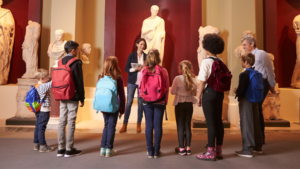
A reframing, reimagining & redesign of language and action
Thinking differently, especially about an institution as established as public education, often requires talking differently. One of the terms that has risen to prominence over the past five years is learning ecosystems. All of us understand intuitively that some of the most valuable learning experiences happen outside of classrooms and schools. The COVID-19 pandemic brought into focus the importance of community settings and community educators to both the pursuit of “formal” academic education and the delivery of a full range of learning and development experiences for kids, families, and teachers.
The platitudes – Learning happens everywhere. Schools can’t do this alone – allude to the idea that schools, families, community-based organizations should somehow work together as a part of a learning ecosystem. Making the leap from school system to learning ecosystem, however, isn’t easy, especially when the purpose of a learning ecosystem is to give each child equitable opportunities to discover who they are, what their gifts are, and to have these strengths formally acknowledge so that they can contribute fully in the world. Kelly Young, CEO of Education Reimagined, consistently points out that achieving this comprehensive goal is nearly impossible given that discrete undertakings (like credentialling learning) that require linking formal and informal systems has proven challenging, even when all parties agree that it is preferred.
“To ask school leaders who are tasked with and regulated administering the system as it is currently designed to design a new system that leverages the assets – human and institutional – in our communities is foolhardy. Not because the people in public education aren’t visionary or capable, but because they have a full-time job serving our kids in the current design of education. We are talking about a dramatic shift in the aim and function of an institution. That shift will not happen by just adding things onto the current education system. It will take outright redesign to enable the kinds of learning that respects and challenges kids, and gets them in the driver’s seat of their learning and life,” Young states.
I, along with multiple trusted colleagues like Young, have spent the past two years looking for language and concepts that bring the difference between system and ecosystem thinking into focus. I took a pilgrimage back to Bronfenbrenner’s human ecology model and sought to simplify language while clarifying the differences between systems and ecosystems. I explored Akiva, Blyth & Hecht’s reframing of ecosystems which leverages Merita Irby & my longstanding framing of people, places, and possibilities and their reflection on core ecosystems principles such as ecosystem health (read their chapter in the recent It Takes an Ecosystem volume). More recently, I’ve been revisiting frameworks for community implementation of youth development strategies and the infrastructure needed to support ecosystem. (We’ll be sharing additional blogs connected to each of these in the coming months.)
As we progress through these explorations I believe we are getting closer to language that helps us heed Young’s caution and consider how we are both transforming systems and intentionally tending to the ecosystem health and connectivity. I was delighted to learn, from Kelly, about Thomas Arnett’s commitment to do a series of posts on the Christensen Institute site exploring different theories that can inform this topic.
In his first post, Arnett introduces a new framework – modularity theory – to explain how different parts of a system’s architecture relate to one another and how they fit and work together in order to achieve desired outcomes. And he introduces new terms – interdependent vs. modular interfaces – to explain the fundamental difference between systems and ecosystems. School systems have a myriad of interdependent interfaces. Synchronized class shifts require bell systems. Curriculum mandates have to interface with instructional standards and professional development. Course credits have to interface with attendance and achievement data. These interdependencies keep non-system providers out (even when invited in). They also constrain system providers to only make changes that conform to pre-established rules and processes.
Non-integrated systems, in contrast, depend on modular interfaces to coordinate the work of independent providers. The providers need to follow rules and standard procedures, but they don’t have to coordinate closely with each other or do things in similar ways once rules for joining the ecosystem are established (e.g. learning mission, minimum staffing and safety requirements, program components, student progress goals). A library, a museum, and a youth organization could take different approaches to engaging kids in learner-centered, competency-based learning. Examples of non-integrated learning systems exist now: early childhood education, STEM, out-of-school and summer learning are all examples of non-integrated, community-based systems supported by national infrastructures.
The modular, non-integrated approach, as Arnett notes, has trade-offs different from, but perhaps no less important than, those associated with the integrated school system that we all grew up with. The opportunity we have, given COVID-related “wall-softening” and American Rescue Plan Act funding, is to acknowledge the fact that scaled examples of non-integrated approaches exist and stive to understand how, when, where, why and for whom they work so we can give them “the runway they need to become viable alternatives to conventional education.” Arnett’s framing helps us begin to think about this runway needed for viable alternatives, but the lessons we can learn from each.
I offer only one edit to the big question at the beginning of the article, “Might it be possible to develop learning ecosystems that stack various learning experiences together to create a formal education?”
Let’s find a new term to replace “formal” it comes with too much baggage. A first step towards elevating the potential of non-integrated learning systems is to celebrate the power of non-classroom educators as equally valid deliverers of knowledge and skill building opportunities. Because they are not as tightly bound by interdependent policies and practices, community educators (including those operating in the school community beyond the classroom) have fewer mandates but more natural opportunities to connect with each other.
I expect that the need for a new term and the value of exploring the potential for seeing the full complement of school and community staff as bridgers between the integrated system we call school and the non-integrated systems referred to as informal, afterschool, out-of-school, or youth development systems will be even more important as Arnett’s continues to explores innovation theories.
I’m reflecting on the second installment now. Stay tuned.
Read both Arnett’s first installment on which I reflect here and his second, which is now available. Share your thoughts here and on social media. How does Arnett’s framing help us begin to advance toward the dramatic shift needed to move from a focus on learning within school systems to a full realization of the power of learning ecosystems?
Karen currently serves as a Senior Fellow with Education Reimagined. In this role she is continuing the language exploration outlined here and lifting up the places and spaces where “modular, non-integrated” learning is helping change the odds that all children & youth will thrive.





1 Comment
I just listened to the conversation between Karen Pittman and Dr. Ulcca Joshi Hansen. I will be studying this as I continue my own studies in Holistic education and Public School Education. I often reflect back on work by James Moffett author of “The Universal Schoolhouse, Spiritual Awakening Through Education.” Do you know this book?
“A few decades from now people will regard the schooling of today with revulsion, as astonishingly primitive, in the same way we deplore the eighteenth-century treatment of the mentally ill….The very idea of a state compelling people to attend schools contradicts the foundations of modern democracy,…Of the three common aims of education–social responsibility, productive employment, and personal development–governments inevitably slight the last,…” —James Moffett
And now there is a new book, “Toward a Re-Emergence of James Moffett’s Mindful, Spiritual, and Student-Centered Pedagogy” edited by Jonathan Marine, Paul Rogers, Sheridan Blau, and Kathleen Kelly. I believe you would like it. Peace.